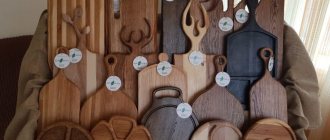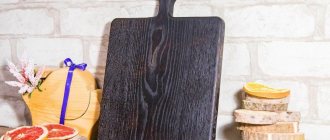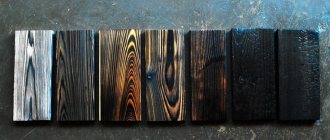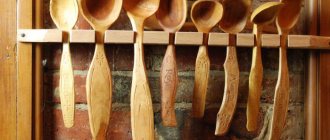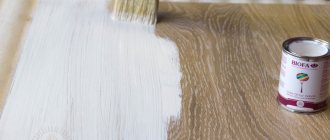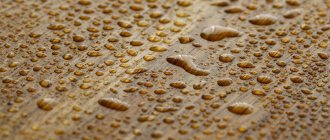Wooden utensils, cutting boards and countertops are work surfaces with maximum mechanical stress. It is difficult to imagine more difficult conditions for coverage. In addition, increased environmental requirements are imposed on dishes and boards. Oils for processing wooden utensils and cutting boards should not contain artificial solvents or components harmful to health. Such a coating should not react with water or hot objects, and at the same time it should have increased dirt and water repellent properties. In other words, not every oil can cope with this task. Therefore, the price of such oil is at a high level.
The old fashioned way: edible flaxseed oil from the store
Many crafters use a homemade mixture of raw linseed oil, beeswax and rosin. What could be more environmentally friendly? Indeed, if we mix all these ingredients and heat them up, we get a simple oil-wax mixture made from natural ingredients. But it’s a stretch to call such a coating harmless to health. The thing is that edible (raw) flaxseed oil, which we are used to seasoning salads with, is healthy only when fresh from the refrigerator. This oil should be stored with the lid tightly closed, excluding air access. The peculiarity of linseed oil is its very rapid ability to oxidize under the influence of oxygen. As a result of oxidation, many free radicals are formed in the oil, which have an extremely negative effect on the entire body. Add to all this the inability of edible flaxseed oil to polymerize (completely dry/harden) and we get an “excellent” cocktail of carcinogens that will enter your body the first time you eat food from dishes or cutting boards treated in this way. It is the inability of the oil to harden inside the wood to form a solid polymer that causes it to enter the body with each use. In general, this is exactly the case when you don’t need to save on your own health and the health of your loved ones. Treating wooden utensils and cutting boards with edible linseed oil is hazardous to health.
Classification and types of oils for interior work
Why impregnate a wooden base with oil? To obtain high-quality protection and extend the durability of the material. For this, various types of oils can be used to impregnate wood; the properties obtained from them may vary slightly.
To decide which oil to treat wood with, take into account the following types of its division:
- Pure formulations, without additional additives;
- Optimized solutions;
- Using thinners in production;
- Wax or non-wax;
- With or without elements that speed up the drying process;
- Combined compositions that can immediately act as an antiseptic, primer mixture and water protection.
To obtain high-quality protection and extend the durability of the material, the wooden base is impregnated with oil.
Mineral/Vaseline oil
Mineral oil or petroleum jelly is a petroleum product. If we omit all the details about the origin of this type of oil, then the main disadvantage of such impregnation of wooden utensils and boards is the complete lack of ability, along with edible flaxseed, to harden. To put it simply, these types of oils are always in a liquid state inside the wood. The deceptive feeling of a dried surface appears because there is simply no oil on the surface. For this reason, dishes and boards treated in this way must be frequently renewed, since the old coating is very quickly washed away and eaten with food. The degree of harm caused to the body can be discussed forever, but the fact remains a fact. In any case, such a coating cannot be called environmentally friendly and harmless. The main difference between processing with mineral oil and edible linseed oil is that mineral oil has no foreign odors and it does not deteriorate inside the wood. In all other respects, with regard to the protective properties, they are close to zero; such a coating provides only a decorative effect.
How to choose depending on the board material?
It is clear that boards are different. They are made from plywood, oak, pine, beech and other wood. Any oil you decide to use will only benefit the product if it is used correctly.
- Pine boards treated with flax seed oil may develop an unpleasant, bitter odor over time.
- Some markets have quite profitable promotions when boards are sold immediately with impregnation in a set. This is a very good offer, since the manufacturer has already selected the composition that is suitable specifically for this wood.
- Vaseline oil is suitable for any type of wood.
- Oak is the most durable, strong and reliable option. Wax is often used to process it. This combination will help give the product durability and allow it to be used for many years. But the impregnation needs to be updated from time to time.
As you can see, there are no difficulties in processing wooden cutting boards. The main thing is to purchase the right oil, which will preserve not only the appearance of the product, but also its quality.
Subscribe to our Social networks
Checking protective properties
To correctly determine the quality of the oil, you need to understand what requirements we place on it. What coating properties are indicators of a quality product?
- The oil should completely polymerize (harden) within a month
- Polymerized oil should not dissolve in water, including in contact with detergents
- When in contact with hot objects, the polymer should not change its properties.
- Polymerized oil should not have any foreign odors
The right oil (oil-wax mixture) inside the wood turns into a solid polymer. This usually takes 20 to 30 days for natural oils. During the polymerization process, all volatile components, including odor, evaporate from the oil. Oil changes from liquid to solid. The polymer obtained as a result of drying the oil becomes inert, namely, it does not enter into any chemical reactions: it does not dissolve in water, is not washed out during use and is not transported into food products, while reliably protecting the wood from the inside.
It is quite easy to check these properties. Take a regular brush and dip it in oil, then place the oiled brush on the windowsill and leave it for about 1 month. After a month, try washing the brush in warm soapy water. If the polymer has not dissolved, then this means that you have high-quality oil.
Wood cutting board oil
Wooden cutting boards can last quite a long time if used properly. However, natural material requires special treatment and care. Using oil to treat a wooden cutting board, you protect it from moisture, prevent deformation and maintain its original appearance. It is easily absorbed, penetrates deeply into the pores of the wood and leaves them open for natural “breathing” processes.
Why do you need oil for a wooden cutting board?
Cutting boards come into contact with sharp knives, water and various foods every day. They are made from an array of popular types of wood - beech, oak, maple, walnut, birch and cherry or exotic - jatoba and mango wood, including bars from the end surface. Regardless of the strength of the structure of the source material, cutting boards need special protection.
Oil treatment:
- Prevents the appearance of stains from coloring products and the absorption of odors. The coating effectively blocks the penetration of juices and liquids from fresh vegetables, herbs, meat, and fish into the wood structure.
- Creates a stable water-repellent effect, prevents waterlogging and cracking of wood when drying. This is especially true during the heating season, when the air in the kitchen becomes dry.
- Provides preventive protection against bacteria and fungus. Treated wood continues to “breathe” and is protected from scratches and microcracks, which create favorable conditions for the development of microorganisms.
The oil creates a very thin and elastic vapor-permeable coating. At the same time, it reliably protects the wood.
What types of oils are there for cutting boards?
Various products are used for impregnation. Before you buy oil for a wooden cutting board, you need to get acquainted with the features of each type.
Types of compositions:
- Mineral oil is a safe petroleum refining product. Most often, its medical analogue is used - pharmaceutical vaseline oil, which can be taken orally, or a cheaper lamp oil. Due to their low viscosity, they penetrate wood well, but have high consumption.
- Natural edible oil. Hemp, nut, and olive oil are used to process the boards. However, edible grades of oils are prone to rancidity upon contact with air, and the appearance of an unpleasant odor and taste, which will be transferred to the product.
- Flaxseed oil and drying oil. Flaxseed oil is actively absorbed and does not go rancid, but it takes a very long time to polymerize. Externally dried coating may leave stains due to the fact that the composition is not dry inside. The surface quickly wears out and gets scratched with intensive use.
- A combination of vegetable oils and waxes. Due to complete polymerization, they do not go rancid, and the large amount of solid particles they contain ensures economical consumption. Waxes help create a more resistant and durable coating with excellent dirt and water repellent properties.
When choosing a product, you need to consider its drying speed and durability. Edible oils, such as flaxseed oil, take a long time to polymerize. Drying takes up to three days for each layer, which may take up to 3-4. Mineral compositions dry up to 8 hours, you need to apply from 2 to 5 layers.
Without additional waxing, both food-grade and synthetic mineral oils for wood cutting boards are unable to provide long-term protection. The coating requires regular and frequent updating.
OSMO wax oil contains driers. It takes 8-10 hours to dry one layer. Thanks to wax, the coating retains its properties for several months even with intensive use of the board.
Basic requirements for board oils
Oil for processing a wooden cutting board should create a reliable and safe coating for people.
Qualitative compositions:
- Harmless. The treated surface can come into contact with raw and prepared food products.
- They do not smell after drying and have no taste. The products do not acquire any foreign tastes or odors.
- They impart hydrophobic properties and make it easier to care for the finished product. The smooth surface is effortlessly cleaned from dirt and can withstand mild detergents.
As a rule, both natural and synthetic products are safe for health. They are highly purified and do not contain toxic impurities or additives.
How to saturate a cutting board with oil
Osmo oil is convenient and easy to work with. It is ready for use and requires only thorough stirring. You can treat new boards before using them or restore used ones.
The surface must first be cleaned of dirt and sanded with fine-grain sandpaper P150-240 (depending on the type of wood). Apply the oil along the grain in an even, thin layer using a flat brush, a small microfiber roller or a soft, lint-free cloth. Remove excess with a napkin to avoid streaks and stains.
A new board is impregnated twice. The second layer is applied after the first has dried. To renew the coating, it is enough to treat the surface cleaned of dirt once.
Oil must be applied on all sides. Impregnation on only one side can lead to deformation of the remaining surface of the product.
How often should the boards be processed?
The coating needs regular updating. The frequency depends on the operating conditions of the board - intensity of use, room humidity, place and method of storage.
It's time to update the surface if:
- the board has lost its color, has become “dry” in appearance, has become lighter in color, or spots have appeared on it;
- the surfaces became rough to the touch, covered with scratches and microcracks at the ends;
- water, juices and liquid from food began to be absorbed rather than remaining on the surface - this is noticeable by long drying times and stains.
Before restoring the coating, it is recommended to sand the surface that has been heavily scratched by knives.
Oils for expressive design
Colorless oils highlight the beauty of wood - its natural shades and natural pattern. They are suitable for dark and light woods, brightening the colors and giving the surface a silky matte shine.
The treated board looks expensive and impressive. This allows you to use it for cutting and serving.
Where to buy quality oil?
The OSMO line includes products for different tasks. You can buy oil for a wooden cutting board from the company’s official dealers or in the official online store. This guarantees originality and quality.
Modern natural compositions based on vegetable oils and waxes
Such compositions do not contain artificial solvents, completely polymerize within a month, and have a certificate of contact of the finished surface with food. The treated, dried surface is completely safe for people, animals and plants.
Thanks to long-term vacuum boiling of various vegetable oils and waxes, the finished oil-wax composition acquires high protective characteristics and the ability to quickly polymerize.
Selection of oils by type of work
This material is put under pressure by various factors, they are different, because the conditions on the street and in the house are different. Therefore, you need to protect objects with suitable elements.
You need to protect objects with suitable elements.
Interior work
The painting process inside the structure must be harmless; the substances must not be toxic. In a house, walls may be affected by humidity, temperature changes, and biological formations. Use formulations suitable for application under given conditions.
The painting process inside the structure must be harmless; the substances must not be toxic.
Exterior works
For work outside, the use of reliable products that are resistant to natural factors is required. They must have a long service life, vapor permeability, and elasticity.
For work outside, the use of reliable products that are resistant to natural factors is required.
Azure for wood
Martyanov wood glaze does not contain waxes, thanks to which it penetrates as deeply as possible even into the hardest fibers of wood, providing reliable protection for the inner layers of wood. In addition, glaze significantly saves expensive finishing oil, the consumption of which is reduced by 2.5 times.
On particularly hard wood, it is recommended to apply 2-3 layers of glaze, leaving each layer for 40-60 minutes until the excess is removed. Remove excess oil from the surface as thoroughly as possible, without leaving a film. In this case, interlayer drying should be at least 24 hours until the previous layer is completely dry before applying the next one. The more time passed between coats, the better. Determining the number of layers of glaze required is very simple: they need to be done until the next layer stops being absorbed after an hour. If you applied another layer of glaze, left it for an hour and after an hour it was practically not absorbed, then the wood has already absorbed the required amount of oil. The number of layers required depends on the absorbency of the particular wood.
Woodworking Basics
During manufacturing, wood is treated with special substances to extend its service life and prevent the problem of rotting, cracking and fungus. All these actions belong to the primary phase of wood processing. The second involves coating a wooden surface with a special varnish or oil.
Oil differs from varnish in the depth of penetration. When applied, varnishing agents create a kind of protective film, which wears off over time. Oil is able to penetrate deep into the structure of the product, thoroughly saturating all wood fibers or other wood components. Another significant advantage of the oil is its ability to change the color of wood, creating unique shades.
Today the market offers a huge selection of oils of different brands and compositions. But all of them can be divided into 2 large groups, which we will consider in more detail later.
Oil for countertops and work surfaces
Unlike glaze, oil for countertops and work surfaces is thicker due to the high content of solid plant waxes and resins. It is also not able to absorb well, but at the same time it is highly wear-resistant, reliably sealing the lower layers.
Wooden utensils or cutting boards treated with glaze and countertop oil, after complete polymerization, acquire 100% hydrophobicity, as well as high dirt and water repellent properties, are not afraid of high temperatures and do not enter into chemical reactions with food.
Features of application
Working with oil is quite simple and does not require special skills. You will need a wide brush, cloth napkins, sandpaper. The choice of a specific device depends on the method: rubbing or soaking.
- The first one is the most popular. It is applicable in cases where it is necessary to cover a large surface. A wooden board is coated with oil using a brush. For the best effect, it is recommended to gradually rub in the solution using napkins or sandpaper. The procedure is repeated several times, alternating application and waiting for each layer to dry completely.
- The second method is more suitable for small parts. They are immersed in a special container filled with oil and soaked for several days. After this, the part must be sanded well.
Oil impregnation is quite easy to use, but indispensable for finishing work. It will help preserve the service life of the wooden structure. The main thing is to take into account all the features. Mineral oil for wood treatment may contain toxic substances, but the drying time is minimal. And natural oil is environmentally friendly, but it will take more than one hour of drying.
Universal composition wax for dishes
Theoretically, this mixture can be used to treat any wood, from walls and floors to dishes, but many are afraid of the presence of turpentine and rosin there. In this regard, it should be noted that turpentine is a volatile substance and it completely evaporates, and rosin, firstly, is harmless to humans and secondly, it is only 5% of the total mass. Flaxseed oil is almost ideal for wood, but, nevertheless, this is not the only option; it can be replaced with olive oil and even sunflower oil. The only thing I wouldn’t recommend doing is pouring machine oil into it; you won’t be able to remove the smell with anything.
Impregnation of wood with linseed oil in its pure form is also practiced, but on large objects the oil must be generously applied 3 to 5 times at intervals of 24 hours, plus after the first time the surface is sanded with fine sandpaper to remove the lint. It is much easier to saturate dishes with clean oil, plus here the wood can also be tinted. To explain it in a nutshell, oil is poured into a container and dishes or crafts are thrown into it.
If the wood just needs to be soaked in oil, then all this is brought to a boil and after 5 - 7 minutes the products are removed. To tint, the pieces will have to be deep-fried, like potatoes. The entire process is shown in detail in the video in this article.
The nuances of processing plywood boards for cutting food
Plywood boards are made from glued together sheets of wood. The material and glue are not resistant to moisture. The product swells and mold forms.
Such utensils require careful handling. It is necessary to protect from glue and moisture. Mineral oil with the addition of beeswax is suitable for this. Algorithm:
- Treat with a soft brush or roller. Which oil to choose for processing.
- Impregnate in the direction of the longitudinal fibers.
- The device is placed horizontally.
- The new board is opened 3 times.
- Each layer is dried for up to 12 hours.
- The remaining composition is removed with a napkin.
- Impregnation is done once a month for the purpose of prevention.
How to prepare the mixture at home
If you were unable to buy the necessary impregnation for the boards in the store, you can easily make it at home, with your own hands. The simplest recipe is:
- buy Vaseline oil at the pharmacy,
- buy beeswax in a specialized store,
- combine 4 parts butter and 1 part wax, cut into pieces,
- melt the mixture in a water bath, stirring to ensure homogeneity,
- cool the product to room temperature,
- Use for wood processing, store in the refrigerator.
It is undesirable to replace beeswax with paraffin or stearin - the latter strongly clog the pores of the wood, which seriously impairs its vapor permeability and can provoke rotting.
Recipes for oil soaks with herbs
For the most sophisticated who enjoy the constant search for something more, there are several recipes for oil infusions. They are made from different types of medicinal herbs and roots:
- Peppermint oil. Pre-dried mint needs to be ground well. The powder from dry leaves should be approximately 100g. Pour it into a glass bottle, add 0.5 liters of linseed oil, seal it and shake thoroughly. Let it sit for about 2 weeks. Don't forget to shake the infusion every day. Then we filter the resulting mint impregnation through cheesecloth.
- Oil with dandelion roots, or with angelica roots. The preparation procedure is the same as in the first option with mint, but in this case the roots of the plants are finely chopped and poured in the proportion of 1 part root to 5 parts oil.
- Collection of seven roots. This oil infusion is good for its strong concentration of tannins contained in plant roots. These substances remain in the oil, and when impregnated with wood, they perfectly strengthen its upper layers. We take burdock, dandelion, elecampane, cinquefoil, meadowsweet, and comfrey roots in equal proportions. The infusion process is exactly the same.
If you want to play around with color a little, you can try different edible vegetable oils. For example, pumpkin and sea buckthorn oils give a beautiful golden hue to a wooden product.
Wax for wooden utensils with added oil
Both clear and colored wood waxes are now strengthening their position in the market and are becoming increasingly popular.
Both clear and colored wood wax are now strengthening their position in the market and are becoming increasingly popular. Modern varnishes and paints are wonderful, but they rarely boast a natural base, while the use of wax has been time-tested and is not only completely safe, but also healthy. In this article we looked at the most well-known compositions, as well as methods of preparation and application with our own hands.
Wood impregnation is done with the addition of oil. Such compositions are good from all sides:
- The oil composition allows the impregnation to penetrate much deeper into the wood;
- All oil mixtures, after hardening, remain either liquid or turn into a paste, which means they are always ready for re-application without heating;
- Oil gives the wood additional shine and a beautiful sheen.
